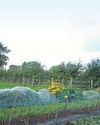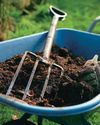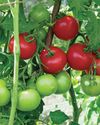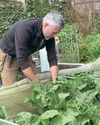
Blight is a virulent fungal disease that can wipe out potato crops or tomatoes very quickly. It can strike from any time after June, and the incidence increases through the growing season.
Most of us who have grown potatoes have seen it at some stage – and organic methods are a good way to manage this disease. But organic management does not mean sitting back and letting the disease run riot. It means taking a range of preventative measures to reduce its chances of breaking out.
WHAT IS POTATO BLIGHT?
First, you need to recognise blight and how it behaves. As it’s airborne, it will infect the leaves first, and you may notice its distinct brown to grey lesions. These are about the size of a penny, and appear close to the edges of leaves. (Don’t confuse this with smaller brown dots which are more likely to be a nutrient deficiency such as potassium or magnesium.)
The disease is far more likely to take hold if the weather is damp and still, as this is ideal for allowing the fungal spores to settle and germinate on the surface of the leaf. In tomatoes, it can be spread by water splash, and in serious infections be seen on the fruit.
HOW TO DEAL WITH A BLIGHT INFECTION
If you notice just a few infected leaves, remove them and dispose of them in your green waste bin where they will be composted at high temperatures. If dry conditions follow, you may be lucky, and the crop can be salvaged.
If you are unfortunate, and the disease becomes widespread throughout the leaves, it might be time to cut your losses.
This story is from the June 2023 edition of Kitchen Garden.
Start your 7-day Magzter GOLD free trial to access thousands of curated premium stories, and 9,000+ magazines and newspapers.
Already a subscriber ? Sign In
This story is from the June 2023 edition of Kitchen Garden.
Start your 7-day Magzter GOLD free trial to access thousands of curated premium stories, and 9,000+ magazines and newspapers.
Already a subscriber? Sign In

SEPTEMBER SPECIALS
This month, with sweetcorn, figs and blackberries on the menu, Anna Cairns Pettigrew is not only serving up something sweet and something savoury, but all things scrumptious

FLAVOURSOME FRUIT AUTUMN RASPBERRIES
September - is it late summer or the start of autumn? David Patch ponders the question and says whatever the season, it's time to harvest autumn raspberries

SOW GREEN THIS AUTUMN
Covering the soil with a green manure in winter offers many benefits and this is a good time to sow hardy types, says KG editor Steve Ott

A HISTORICAL HAVEN OF FRUIT AND FLOWERS
KG's Martin Fish takes time out from his own plot to visit a walled garden in Lincolnshire which has been home to the same family for more than 400 years

RESTORING THE BALANCE
The phrase regenerative gardening is often heard in gardening circles, but what is it? Can it help you to grow better veg? Ecologist Becky Searle thinks so, and tells us why

WASTE NOT, WANT NOT
Garden Organic's Anton Rosenfeld shares his expertise on using compost made from green bin collections with handy tips on getting the right consistency and quality

Celebrating Organic September!
In this special section we bring you four great features aimed at improving your crops and allowing nature to thrive

SEEING RED
Do your tomatoes have a habit of remaining stubbornly green? Or perhaps you're lucky to enjoy lots of lovely fruits - just all at once. Either way, Benedict Vanheems is here with some top tips to ripen and process the nation's favourite summer staple

NEW KIDS ON THE BROCCOLI!
Rob Smith is talking broccoli this month with a review of the different types available and suggestions for some exciting new varieties to try

A NEW kitchen garden
Martin Fish is getting down to plenty of picking and planting on the garden veg plot, while Jill is rustling up something pepper-licking good!